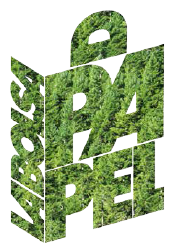The paper bag is grown
Wood, the raw material for making paper is renewable and inexhaustible.
In Europe, in the period 2010-2015 forests have grown by 1,900,000 hectares.
Spain, with 18.4 million hectares, is the fourth largest forest area in Europe and our forests have increased by 27% in the last 15 years.
Only wood that is grown in specific forest plantations for the production of cellulose fiber is used to make paper.
In Spain, thanks to paper production, 420,580 hectares of pine and eucalyptus trees are sustainably managed and have made it possible to recover wasteland and convert it into forests.
The paper bag is grown
Wood, the raw material for making paper is renewable and inexhaustible.
In Europe, in the period 2010-2015 forests have grown by 1,900,000 hectares.
Spain, with 18.4 million hectares, is the fourth largest forest area in Europe and our forests have increased by 27% in the last 15 years.
Only wood that is grown in specific forest plantations for the production of cellulose fiber is used to make paper.
In Spain, thanks to paper production, 420,580 hectares of pine and eucalyptus trees are sustainably managed and have made it possible to recover wasteland and convert it into forests.
The paper bag as a CO2 sink
Plantations of species used to make paper fiber are major CO2 sinks. Once the forest reaches maturity it stops absorbing carbon, so these productive plantations are a great opportunity to contribute to curbing climate change.
The 420,580 hectares of paper plantations in Spain store 28 million tons of CO2 equivalent.
The stored carbon is not released when the tree is cut down but remains in forest products such as paper bags. One kilo of paper stores 1.3 kilos of CO2 equivalent and thanks to recycling the carbon sequestration period is being extended.
The paper bag as a CO2 sink
Plantations of species used to make paper fiber are major CO2 sinks. Once the forest reaches maturity it stops absorbing carbon, so these productive plantations are a great opportunity to contribute to curbing climate change.
The 420,580 hectares of paper plantations in Spain store 28 million tons of CO2 equivalent.
The stored carbon is not released when the tree is cut down but remains in forest products such as paper bags. One kilo of paper stores 1.3 kilos of CO2 equivalent and thanks to recycling the carbon sequestration period is being extended.
The paper bag negative carbon footprint
All industrial activity causes greenhouse gas emissions. The carbon footprint measures the total emissions of a product throughout its life cycle: the procurement and origin of the raw material, the manufacturing and transport processes, its different uses and the practices for its recovery or disposal as waste.
and the practices for its recovery or disposal as waste.
A study conducted to identify the carbon footprint of different types of bags used in commerce revealed the following conclusions:
The paper bag negative carbon footprint
All industrial activity causes greenhouse gas emissions. The carbon footprint measures the total emissions of a product throughout its life cycle: the procurement and origin of the raw material, the manufacturing and transport processes, its different uses and the practices for its recovery or disposal as waste.
and the practices for its recovery or disposal as waste.
A study conducted to identify the carbon footprint of different types of bags used in commerce revealed the following conclusions:
The paper bag is always the best choice.
The paper bag in each and every process of its life cycle has a negative carbon footprint.
The paper bag is more environmentally friendly.
The paper bag is always the best choice.
The paper bag in each and every process of its life cycle has a negative carbon footprint.
The paper bag is more environmentally friendly.




The paper bag is always the best choice.
The paper bag in each and every process of its cycle has a negativecarbon footprint.
The paper bag is more environmentally friendly.


SOURCE: STUDY CONDUCTED BY IVL SWEDISH ENVIRONMENT RESEARCH INSTITUTE FOR BILLERUD AB (20 MARCH 2007)
The paper bag is recyclable and biodegradable.
The Spanish paper industry is the European leader in paper recycling; 4.6 million tons of waste paper are collected and recycled annually.
For every ten kilos of paper manufactured in Spain, 8.2 kilos of waste paper are used as raw material. Paper recycling reduces the pollutant emissions produced by landfills and saves on the volume of waste paper used.
The recycling of paper reduces the polluting emissions produced by landfills and saves the equivalent volume of 50 large soccer stadiums such as the Bernabeu or Camp Nou.
We recover and recycle 74% of the paper bags we consume. As a result, each paper bag has up to six life cycles, since cellulose fiber can be recovered up to six times as a raw material. And if a paper bag were to end up in nature by mistake, it would not harm the earth or the oceans. Being a natural product, it would biodegrade in 2 to 5 months without harming the environment, unlike other commercial bags that can take more than 400 years to decompose.
The paper bag is recyclable and biodegradable.
The Spanish paper industry is the European leader in paper recycling; 4.6 million tons of waste paper are collected and recycled annually.
For every ten kilos of paper manufactured in Spain, 8.2 kilos of waste paper are used as raw material. Paper recycling reduces the pollutant emissions produced by landfills and saves on the volume of waste paper used.
The recycling of paper reduces the polluting emissions produced by landfills and saves the equivalent volume of 50 large soccer stadiums such as the Bernabeu or Camp Nou.
We recover and recycle 74% of the paper bags we consume. As a result, each paper bag has up to six life cycles, since cellulose fiber can be recovered up to six times as a raw material. And if a paper bag were to end up in nature by mistake, it would not harm the earth or the oceans. Being a natural product, it would biodegrade in 2 to 5 months without harming the environment, unlike other commercial bags that can take more than 400 years to decompose.
The “labolsadepapel” platform has created an environmental symbology to help retailers defend the sustainability of the bags they offer to their customers and to convey to consumers the values of the paper bag as an environmentally responsible good.

In the symbology are represented the attributes of the paper bag as:
RENEWABLE, since its raw material, cellulose fiber, is inexhaustible, grown specifically in responsibly managed forests.
BIODEGRADABLE, the paper bag, being made with natural fibers, printed with water-based inks and ecological glues, degrades in a short period of time without damaging the natural environment.
RECYCLABLE, a paper bag can be recycled up to six times, extending its useful life and minimizing the volume of deposits in landfills.
REUSABLE, it has been demonstrated that paper bags can be reused a minimum of five times to re-purchase the same type of product for which it was purchased.
It is also common for paper bags to carry forestry certification.
Forest certification is a program through which an independent entity guarantees that a forest product comes from wood from a sustainably managed forest. It certifies, firstly, that the management of the forest area complies with sustainability criteria, this includes the forest inventory, management planning, silviculture, harvesting, as well as the ecological, economic and social impacts of forestry activities.
Then, when the certified wood enters the industrial process, the chain of custody (its traceability from the forest to the final consumer) is controlled and certified. Finally, consumers receive the product with a label that guarantees its origin from a sustainably managed forest.
The main forest certification and chain of custody programs are:


“Forest Stewardship Council” (FSC) and the “Programme for the Endorsement of Forest Certification” (PEFC).
In short, environmental labels help to certify the commitment of businesses to a sustainable and environmentally friendly economy.
The “labolsadepapel” platform has created an environmental symbology to help retailers defend the sustainability of the bags they offer to their customers and to convey to consumers the values of the paper bag as an environmentally responsible good.

In the symbology are represented the attributes of the paper bag as:
RENEWABLE, since its raw material, cellulose fiber, is inexhaustible, grown specifically in responsibly managed forests.
BIODEGRADABLE, the paper bag, being made with natural fibers, printed with water-based inks and ecological glues, degrades in a short period of time without damaging the natural environment.
RECYCLABLE, a paper bag can be recycled up to six times, extending its useful life and minimizing the volume of deposits in landfills.
REUSABLE, it has been demonstrated that paper bags can be reused a minimum of five times to re-purchase the same type of product for which it was purchased.
It is also common for paper bags to carry forestry certification.
Forest certification is a program through which an independent entity guarantees that a forest product comes from wood from a sustainably managed forest. It certifies, firstly, that the management of the forest area complies with sustainability criteria, this includes the forest inventory, management planning, silviculture, harvesting, as well as the ecological, economic and social impacts of forestry activities.
Then, when the certified wood enters the industrial process, the chain of custody (its traceability from the forest to the final consumer) is controlled and certified. Finally, consumers receive the product with a label that guarantees its origin from a sustainably managed forest.
The main forest certification and chain of custody programs are:




“Forest Stewardship Council” (FSC) and the “Programme for the Endorsement of Forest Certification” (PEFC).
In short, environmental labels help to certify the commitment of businesses to a sustainable and environmentally friendly economy.
 info@labolsadepapel.com
info@labolsadepapel.com








